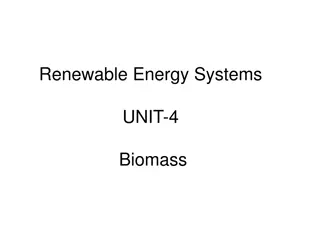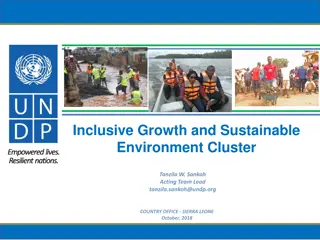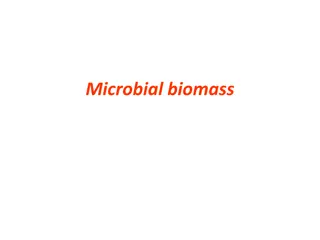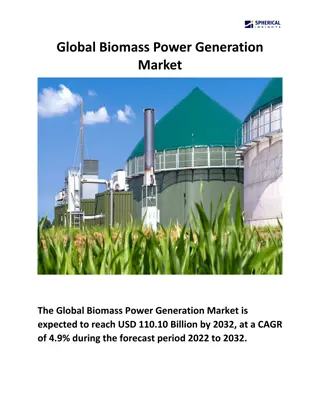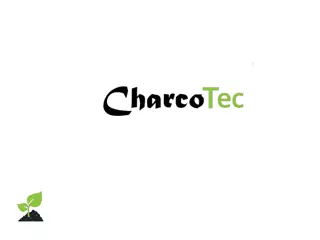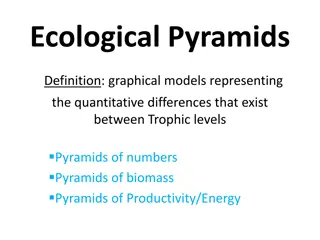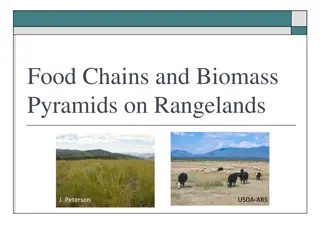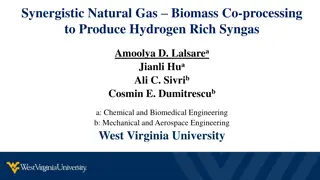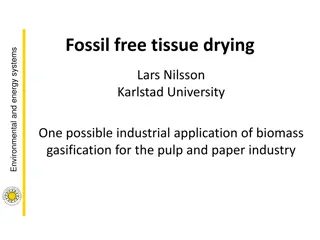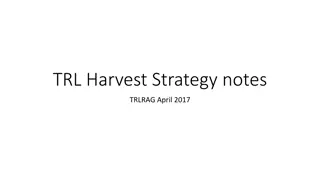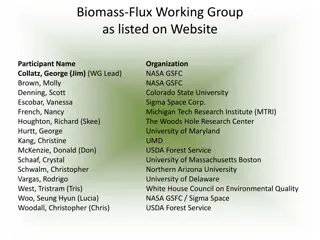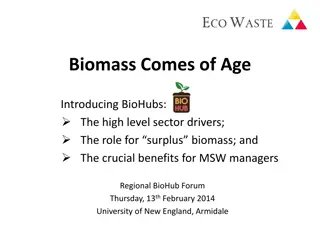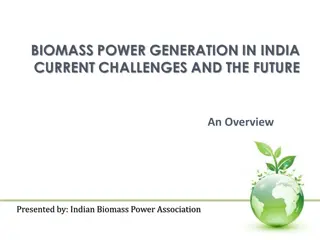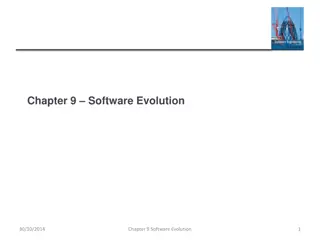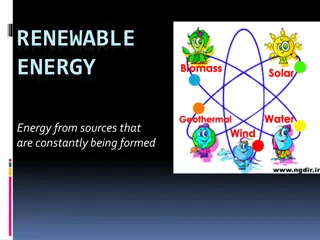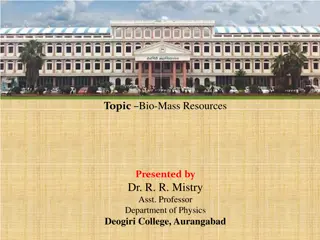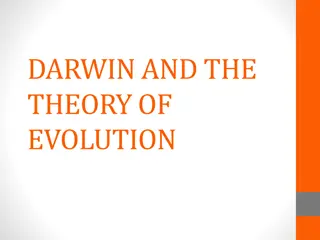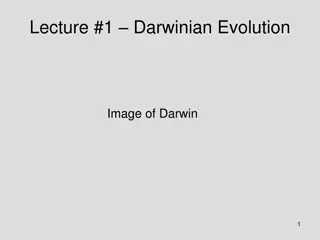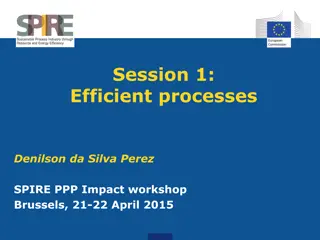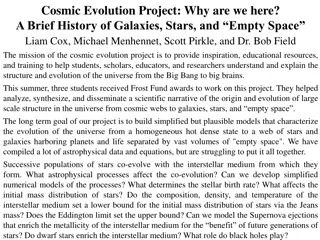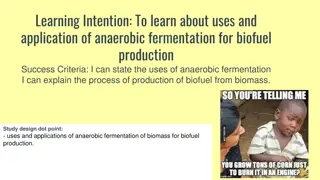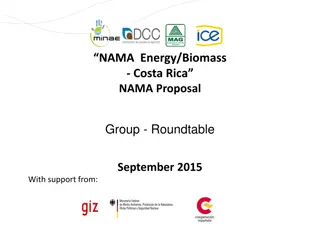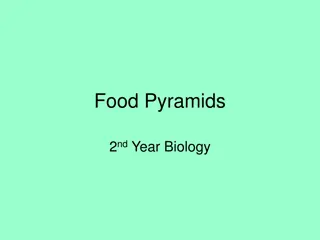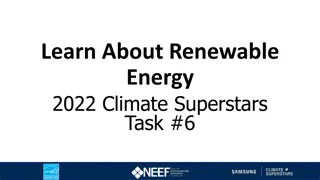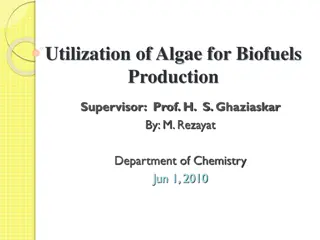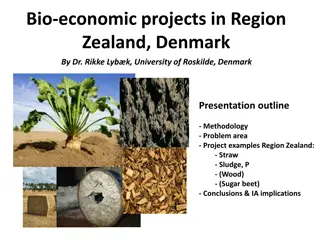The Role of Biomass in the Energy Mix: Perspectives and Prospects
Biomass plays a crucial role in the energy transition, with significant potential for renewable energy use. Various reports highlight the importance of sustainable biomass utilization in achieving carbon neutrality. While biomass alone may not meet all energy needs, it contributes substantially to F
6 views • 25 slides
Renewable Energy Systems - Biomass Energy Conversion and Applications
Biomass, a renewable energy source, is abundantly available in organic matter such as dried woods, leaves, and cow dung. Through photosynthesis, solar energy is converted into biomass energy. Different conversion processes including direct combustion, thermochemical, and biochemical methods are util
0 views • 30 slides
Enhancing Inclusive Growth and Environmental Sustainability in Sierra Leone
Sierra Leone, with abundant natural resources, faces economic and social challenges, high youth population, extreme poverty, and climate change vulnerabilities. The Inclusive Growth and Sustainable Environment Cluster aims to promote natural resource governance for economic growth while preserving t
0 views • 21 slides
Industrial Applications of Microbial Biomass Production
Microbial biomass has various industrial applications such as the production of single-cell proteins, antibiotics, ethanol, and organic acids. This biomass can serve as a valuable resource for seed cultures, silage production, biopesticides, animal fodder, and more. Yeasts like Saccharomyces cerevis
2 views • 17 slides
Global Biomass Power Generation Market
\"The Global Biomass Power Generation Market is expected to reach USD 110.10 Billion by 2032, at a CAGR of 4.9% during the forecast period 2022 to 2032. \n\n\"\n
0 views • 5 slides
Efficient Biomass to Charcoal Technology Philosophy Overview
The technology, initiated in 2012, focuses on high efficiency biomass to charcoal conversion with a robust and simple approach. It emphasizes no hazardous emissions, affordable production costs, and the use of readily available construction materials. The philosophy involves separating heating from
0 views • 20 slides
Maximizing Biomass Sector Growth in Namibia through Thermal Processing Technologies
The Namibia Biomass Research Symposium 2023 emphasizes the potential of the Namibian biomass sector in igniting growth through thermal processing of encroacher bush-based biomass. With vast untapped biomass stocks and a focus on thermochemical and direct combustion technologies, the symposium highli
0 views • 12 slides
Understanding Ecological Pyramids: Models of Trophic Relationships
Ecological pyramids are graphical models that depict quantitative differences between trophic levels in an ecosystem. They come in three types: Pyramids of Numbers, Pyramids of Biomass, and Pyramids of Productivity/Energy. Pyramids of Numbers show the number of organisms at each trophic level, Pyram
0 views • 4 slides
Understanding Food Chains, Trophic Levels, and Biomass Pyramids on Rangelands
Explore the intricate dynamics of food chains, trophic levels, and biomass pyramids on rangelands through informative visuals and explanations. Learn how energy flows through different levels, the concept of biomass pyramids, and the impact of vegetarianism on food chains and energy efficiency.
0 views • 11 slides
Enhancing Ecological Sustainability through Gamified Machine Learning
Improving human-computer interactions with gamification can help understand ecological sustainability better by parameterizing complex models. Allometric Trophic Network models analyze energy flow and biomass dynamics, but face challenges in parameterization. The Convergence Game in World of Balance
0 views • 12 slides
Green Energy Transition in Nigeria: Opportunities and Challenges
Nigeria faces challenges in meeting its energy demands, with a large population lacking access to reliable electricity. The transition to green energy sources like solar, biomass, hydro, and wind presents investment opportunities to address these issues. Solar energy potential is high in Nigeria, wh
1 views • 9 slides
Synergistic Co-Processing of Natural Gas and Biomass for Hydrogen-Rich Syngas Production
Examining the synergistic co-processing of natural gas and biomass to produce hydrogen-rich syngas, this study explores reactor configurations, motivation for lab-scale gasification, challenges in biomass utilization, and catalyst-based design of experiments. Results and discussions cover gasifier r
0 views • 21 slides
Evolution of Compact Star-Forming Galaxies and Quiescent Galaxies
The evolution of galaxies from compact star-forming to quiescent states involves processes such as secular evolution, gas inflows, and star formation quenching. By studying the structural relations and star formation in these galaxies, insights are gained into their transition towards quiescence. Th
0 views • 12 slides
The Scopes Monkey Trial: Clash of Cultures and Evolution Debate
Following World War I, the Scopes Monkey Trial in Tennessee marked a pivotal clash between urban and rural cultures over the teaching of evolution. The trial, prosecuted by William Jennings Bryan and defended by Clarence Darrow, resulted in teacher John Scopes being found guilty of violating the ant
0 views • 9 slides
Cover Crop Nitrogen Availability Calculator
Cover crops can impact nitrogen availability for cash crops. This calculator helps estimate nitrogen availability from cover crop biomass, guiding N management decisions. It requires data on cover crop biomass and composition. Positive values suggest a nitrogen credit, while negative values indicate
0 views • 7 slides
Understanding Carbon Storage in Biomes and Ecosystems
Explore the intricate carbon cycle within terrestrial ecosystems, focusing on carbon storage in biomass, litter, and soil. Delve into the differences in plant characteristics among various biomes and their impact on carbon sequestration. Gain insights into the distribution of tropical rainforests an
0 views • 13 slides
Enhanced n-Butanol Production from Lignocellulosic Biomass Hydrolysates
Biofuels production from lignocellulosic biomass offers a promising solution to replace conventional substrates. This study focuses on enhancing n-butanol production using metabolically engineered Clostridium tyrobutyricum immobilized in a fibrous-bed bioreactor. By utilizing agricultural residues l
0 views • 22 slides
Biomass Gasification for Pulp and Paper Industry Sustainability
Explore the sustainable application of biomass gasification in the pulp and paper industry, focusing on fossil-free tissue drying and energy systems. Discover proposed gasification technologies and the potential impacts on energy production and environmental sustainability.
0 views • 19 slides
Effective Harvest Strategy Implementation for Sustainable Fisheries Management
The Harvest Strategy Framework prioritizes maximum economic yield and stakeholder-preferred biomass levels to guide fishing activities. It involves key reference points such as target biomass (BTARG) and limit biomass (BLIM) to maintain stock sustainability. Closure rules and subsequent actions are
0 views • 7 slides
Social, Economical, and Technical Impact of Clean Energy Technologies
This course covers the management of micro-level clean energy projects, emphasizing the social, economic, and technical impacts of selected clean energy technologies. It discusses project organization, tools, project life cycle, financial analysis, barriers, capacity building, and more. It delves in
0 views • 32 slides
Rules and Practices for Software Evolution Support
This content focuses on the importance of rules and practices to support software evolution, addressing challenges, benefits, and impact on ecosystems. It emphasizes the need for system-specific rules, automatic extraction of conventions, and client support. The evolution of software is highlighted
0 views • 65 slides
Biomass-Flux Working Group Overview
The Biomass-Flux Working Group, a collaboration involving various organizations like NASA and universities, aims to integrate land-atmosphere carbon fluxes and biomass changes to enhance estimations and understanding. By identifying overlapping projects, encouraging cross-comparisons, and reconcilin
0 views • 10 slides
Exploring the Evolution of Biomass in BioHubs for Sustainable Resource Management
Advancements in biomass utilization through BioHubs offer a sustainable solution to address global agendas like climate change and resource depletion. Biomass serves as a crucial alternative to fossil fuels, providing a renewable source for essential carbon-based molecules. Various biomass sources,
0 views • 17 slides
Overview of Indian Biomass Power Association
Indian Biomass Power Association presents an overview of the Indian power scenario, showcasing the growth of renewable energy generation, the challenges faced by the power sector, the need for renewable energy to reduce carbon dioxide emissions, and the comparison of biomass and wind power potential
0 views • 16 slides
Energy Sources and Feasibility Study in Fremont County
Explore the feasibility of various energy sources in Fremont County, including biomass, natural gas, wind, and tax incentives. The study delves into the pros and cons of each energy source, tax benefits, and the potential for green energy initiatives. It covers details on biomass cost, facility expe
0 views • 19 slides
Harvard Forest Schoolyard Ecology Data Analysis Workshop 2016
Compilation of teacher-developed graphs and data documents from the Harvard Forest Schoolyard Ecology Workshop 2016. The documents include comparisons of tree species by plot, number of tree species, carbon biomass, and biomass distribution across different species and plots. Additionally, the analy
0 views • 22 slides
Software Evolution: Managing Change and Evolution in Organizational Systems
Software evolution is an essential process for organizations to maintain the value of their critical business assets. It involves adapting to new requirements, addressing errors, and enhancing performance. The majority of software budgets in large companies are dedicated to evolving existing systems
0 views • 61 slides
Exploring Renewable Energy Sources
Renewable energy is derived from constantly replenished sources such as solar power, wind power, biomass, hydroelectricity, and geothermal energy. These sustainable sources offer clean alternatives to traditional fossil fuels, contributing to a greener future. Solar energy utilizes the sun's power t
0 views • 16 slides
Biomass Resources: A Sustainable Energy Source Explored by Dr. R. R. Mistry
Biomass, as presented by Dr. R. R. Mistry, consists of various resources such as trees, cultivated plants, algae, urban waste, and rural waste, which play a crucial role in generating energy through photosynthesis. The conversion of solar energy into biomass energy is primarily achieved through this
0 views • 20 slides
Darwin and the Theory of Evolution: A Comprehensive Overview
Darwin's Theory of Evolution encompasses the concepts of organisms changing over time and life evolving through natural selection. Influenced by scientists such as James Hutton, Jean Baptiste Lamarck, and Alfred Russel Wallace, Darwin's theory culminates in the idea of evolution by natural selection
0 views • 9 slides
Understanding Evolution: Key Concepts and Perspectives
Explore the concepts of Darwinian evolution, evidence for evolution, Darwin's theory, and the Modern Synthesis. Delve into the spiritual versus intellectual perspectives, the diversity of religious affiliations globally, and the compatibility of faith and science in understanding the natural world a
0 views • 91 slides
Technological Impact in Biomass Processing for Renewable Resources
This content highlights the technological impact and processes involved in efficiently utilizing biomass for renewable resources. It discusses innovative methodologies to upgrade diverse biomasses for chemicals production, bioenergy, and biofuels. The development of advanced technological solutions,
0 views • 22 slides
Unveiling the Cosmic Evolution: A Journey Through Galaxies, Stars, and Empty Space
Delve into the intricate story of the universe's evolution from its hot dense origins to the vast cosmic web of stars and galaxies. Explore questions on stellar birth rates, interstellar medium influences, and the role of dark energy. Follow the journey of three students working on the Cosmic Evolut
0 views • 30 slides
Anaerobic Fermentation for Biofuel Production: Uses and Applications
Anaerobic fermentation is a key process converting biomass into biogas without oxygen. Biofuels, such as bioethanol and biodiesel, derived from biomass like agricultural and industrial waste, offer renewable and environmentally friendly energy alternatives. The applications of anaerobic fermentation
0 views • 11 slides
Sustainable Energy Proposal for Biomass Utilization in Costa Rica
Costa Rica's NAMA Energy/Biomass proposal aims to support the energy sector by promoting the use of organic agricultural and forestry residues for clean energy production. The project focuses on optimizing value chains, improving energy efficiency, developing monitoring systems, incorporating enviro
0 views • 24 slides
Understanding Food Chains and Pyramids in Biology
Explore the concepts of food chains, energy flow, and pyramids in biology through a detailed presentation covering topics such as energy loss, pyramids of numbers, biomass, and the impact of large organisms in ecosystems. Discover how these interconnected aspects help us understand the dynamics of h
0 views • 9 slides
Understanding Renewable Energy and its Benefits in 2022
Renewable energy sources like wind, waves, tides, sunlight, geothermal heat, and biomass play a crucial role in combating climate change by reducing greenhouse gas emissions. This task educates about the differences between renewable and non-renewable energy sources, the benefits of renewables, and
0 views • 10 slides
Utilization of Algae for Biofuels Production: A Comprehensive Overview
Algae, both microalgae and macroalgae, hold immense potential as sources of biofuels due to their high productivity and adaptability. Microalgae, in particular, are highlighted for their rapid growth rates and efficient photosynthesis, making them ideal for mass production with minimal land and wate
0 views • 31 slides
Evolution of Indo-European Languages through Phylogeny Estimation
Explore the evolution of Indo-European languages through phylogeny estimation under a model of linguistic character evolution. Follow the Computational Historical Linguistics Project's collaboration that began in 1994, leading to the development of methods and studies on homoplasy-free evolution and
0 views • 61 slides
Bio-Economic Projects in Zealand, Denmark: Enhancing Sustainable Biomass Utilization
Dr. Rikke Lybk from the University of Roskilde in Denmark presents bio-economic projects focusing on utilizing biomass resources like straw, sludge, wood, and sugar beet residues in Zealand. The methodology involves leveraging existing technology, circular economy principles, and new pathways to cre
0 views • 6 slides

